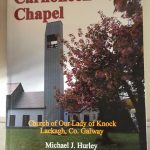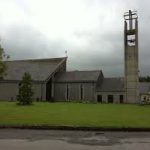During the summer of 2019 Dr. Hilary Bishop of Liverpool’s John Moore University conducted a survey on the Mass paths of Lackagh Parish in conjunction with the Lackagh Museum and Community Development Association.
The intention was to produce an academic paper on the subject of the Mass paths and also in conjunction with photographer Catriona Dunnett to mount an exhibition in NUIG of photographs of the Mass paths.
However Covid intervened and it is only now that Hilary has produced a small booklet entitled ‘A Well-Trodden Path’ of her photographs but she still hopes to mount an exhibition in Galway Library before the end of this year.
On Saturday last Dr. Hilary Bishop finally presented her paper in a talk in Lackagh Museum. Her paper had been published in the journal of the Geographical Society of Ireland in January of this year. The report was produced by Dr. Bishop with Michael Hurley of Lackagh Museum. The chairman of Lackagh Museum Gerry McDonagh introduced the evening and welcomed Dr.Bishop back to Lackagh. He thanked her for her work in relation to the parish and assured all present that she was leaving a lasting legacy to the museum and the community of the parish.
During her talk Hilary used slides to illustrate her work. In commencement she explained that landscape is not just markings on a map or a GPS navigation address or an Eircode.
She cited Tim Robinson and his books on Connemara and noted Tim’s deep understanding of the complexity of the Irish landscape and the ways it had been layered by the passage of time.
Robinson maintained that landscape was not merely topography but also the embodiment of human perspectives on that topography. He believed that we as humans create the landscape and an overlay of layers within that landscape.
Hilary said that places stretch through time and that memories and traditions of the people associated with place do not only exist in the past they can also be actively built in the present. People create meaningful attachments to the places in which they live and these attachments are strengthened by the activities that people pursue in that location.
Memory maps are able to locate objects, images and ghosts and she quoted one person who said:’Some of these journeys remain forever in one’s memory. Such as seeing the flashlights moving slowly through the fields on the dark evening of a Mission or going to 7.30a.m. Mass on a Christmas morning as the frosty grass shone in the light of the moon at the break of day’.
Changing farming practises and a falling off in population have weakened the link between people and land in much of the west of Ireland. New work practises within the farming community now mean that the farmer spends much of his time in outside work and farming does not occupy a full time position.
Hilary pointed out that Mass paths do not have any official recognition or history because when the country was mapped nearly two centuries ago Mass paths were not integral to the requirements of the mapping which were the enabling of the collection of taxes and rates in a non-Catholic regime.
Prior to the main study here in Lackagh, the Museum Committee produced an initial map with the known Mass paths marked thereon.
When Hilary Bishop arrived a community workshop was held where people came and pointed out specific sites, and stiles and additions to the information already on the maps.
A series of walks and interviews followed and with the generous cooperation of local farmers the paths were walked as far as could be remembered. The information collected could not have been included in the study were it not for the kind assistance and cooperation of the local people.
The routes along the Mass paths varied from place to place, mostly dictated by the topography of the land and the type of terrain. The route of the Mass path could be dictated by the time of the year and the conditions of the field and thus some paths took alternative directions especially during times of flooding.
Stone stiles were erected where people had to cross from one field to another and many of these stiles which are still in existence were unearthed from beneath a growth of brambles and grasses all of which had been long forgotten.
The farmers in Lackagh parish never ploughed through Mass paths even though it would have been easier to plough through them to lift a horse plough every time the path was encountered.
Hilary pointed that of the 10 people who gave interviews or accompanied walks during the study, four are now deceased – Cissy Commins, Peter Farragher, Johnny Grealish and Monica Holland.
She pointed out and stressed the importance of gaining information from people within a community as with every death in the parish more memories are lost and forgotten.
Copies of the paper have been made available free of charge with the compliments of Liverpool’s John Moore University and they may be had from Lackagh Museum.



